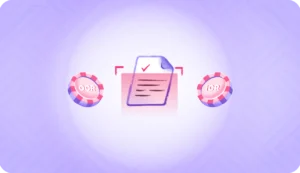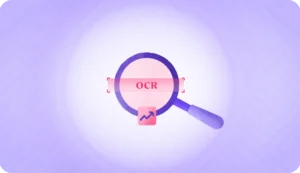Navigating the world of document digitization, we often come across two key players: Optical Character Recognition (OCR) and Intelligent Character Recognition (ICR). These technologies are pivotal in transforming physical documents into digital assets, but they cater to different needs.
OCR, known for its efficiency in reading printed text, works like a charm for various use cases such as document verification and beyond. ICR is the more advanced cousin of OCR, which can handle a variety of handwriting styles and even cursive writing. This makes it ideal for more complex tasks, such as automating manual data entry from handwritten forms.
This blog will cover the key differences between these technologies, delving into the pros and cons, and a guide to choosing the right one for your unique needs. Let’s begin!
What is optical character recognition?
Optical Character Recognition (OCR) is a technology that converts different types of documents, such as scanned paper documents, PDF files, or images captured by digital cameras, into editable and searchable data. At its core, OCR online software works by analyzing the graphical elements of a document and identifying the patterns of characters or symbols within it.
Read more: A Complete Overview of OCR Technology
Key Characteristics and Functionalities of OCR Systems:
- Pattern and Feature Recognition: Initially, advanced Optical Character Recognition technology utilized pattern recognition, which required exact pixel matches to a library of known fonts. However, this method had limitations due to the vast variety of fonts. Modern OCR has evolved to use feature detection, focusing on the specific characteristics of each character. This approach allows OCR to recognize characters in a wide range of fonts and styles, even under challenging conditions like faded ink or degraded images.
- Document Segmentation: OCR software segments a document into lines or words and further into individual characters. Using machine learning and pattern recognition, it matches these graphical components to their corresponding textual elements in a pre-defined character database. This segmentation is crucial for accurately extracting textual data from images.
- Application in Various Industries: OCR technology finds extensive uses across multiple sectors. In finance, it automates data extraction from documents like invoices for accounts payable systems and contracts. In the legal field, it converts scanned documents into searchable text, aiding in research and case preparation, so using OCR in contract management plays a very important role. It helps to extract key terms and conditions from the contract and streamline the contract review process. The insurance industry uses OCR to process claims and policies efficiently, while healthcare providers benefit from OCR in digitizing patient records.
- Integration and OCR Automation: Incorporating OCR into applications enhances document processing capabilities. Developers can integrate OCR APIs to add text recognition features to their applications, automating the extraction of information and significantly improving productivity in sectors like finance, legal, insurance, and healthcare.
What is intelligent character recognition?
Intelligent Character Recognition (ICR) is a more advanced form of character recognition technology, specifically designed to interpret and process handwritten text and other unstructured forms of handwritten data. ICR not only recognizes characters but also understands their context and variations in handwriting.
Features that Differentiate ICR Technology from OCR:
- Contextual Understanding: ICR goes beyond mere recognition. Utilizing Artificial Intelligence (AI) and Natural Language Processing (NLP), it comprehends the context of the text, which is particularly useful in deciphering diverse handwriting styles and cursive writing.
- Adaptability to Handwritten Text: Unlike OCR, which excels with printed text, ICR is specifically tailored to interpret handwritten characters, which are inherently more variable and less structured than typed characters.
- Continuous Learning: ICR systems are designed to learn and improve over time. They can adapt to new handwriting styles and become more accurate as they process more data, thanks to machine learning algorithms.
- Customizable and Scalable: ICR technology is highly customizable for specific use cases and scalable to handle large volumes of data, making it ideal for various applications, from form processing to historical document digitization.
How do optical and intelligent character recognition software work?
Character recognition technology, whether OCR or ICR, works by analyzing images of text and converting them into machine-readable text data. ICR continuously adapts and learns from new data, making it more flexible and accurate over time, especially in handling unstructured data. This process involves several steps:
- Image Preprocessing: The image is prepared for recognition, involving adjustments such as de-skewing, noise reduction, and contrast enhancement.
- Segmentation: The text is segmented into smaller components like lines, words, and characters.
- Character Identification: The system recognizes each character by comparing it against a database of known characters.
- Contextual Analysis: For ICR, this step involves understanding the context and nuances of the text, particularly in handwritten documents.
Read more: What is machine readable zone and how does it work?
Key differences between OCR and ICR
The primary differences between OCR and ICR can be understood in terms of their handwriting recognition, scope, and capabilities, how they handle handwritten text, and their contextual understanding and data extraction methods. Here’s a comparative overview presented in a table format for clarity:
| Feature | OCR | ICR |
| Recognition Scope and Capabilities | Primarily focused on printed text, with high accuracy in structured formats. | Designed to process both printed and handwritten text, adaptable to a variety of formats. |
| Handling of Handwritten Text | Limited effectiveness, best with clear and structured printing. | Excellently handles a wide range of handwriting styles, including cursive and informal writing. |
Read more: Buyer’s Guide to Choosing the Best OCR software
Benefits and limitations of ICR and OCR
Pros and Cons of OCR Technology:
| Pros | Cons |
| High accuracy with printed text | Limited contextual understanding |
| Can extract information from a variety of file formats and languages | |
| Cost-effective for large-scale use |
Pros and Cons of ICR Technology:
| Pros | Cons |
| Advanced Handwriting Recognition | Generally more expensive than OCR |
| Contextual Data Understanding | Requires more computing power |
| Continuous Learning and Adaptability |
OCR vs. ICR: Choosing the right technology for your needs
When deciding between Optical Character Recognition (OCR) and Intelligent Character Recognition (ICR) or Intelligent Word Recognition (IWR), several factors need to be considered to ensure that you choose the best intelligent character software technology that suits your specific requirements. The choice of OCR vs ICR depends on the nature and complexity of the text you need to process. Here’s a table that explains the factors that should be considered while choosing the software:
| Factor | OCR | ICR |
| Type of Text | Ideal for structured, machine-printed text | Excels in interpreting unstructured or handwritten text |
| Document Complexity | Best suited for documents with clear, printed text | Better for documents with varied fonts, handwriting styles, or poor condition |
| Cost and Resources | Generally more cost-effective and less resource-intensive | Potentially more expensive and resource-intensive due to advanced capabilities |
| Recognition Accuracy | Excellent for recognizing standard printed text | Superior in recognizing diverse handwriting and unstructured text |
| Contextual Understanding | Basic, primarily focused on pattern matching | Advanced, with an AI-driven understanding of context and nuances in text |
Remember, the choice between OCR and ICR software should align with your specific document and data processing needs, considering the type of text you’ll be working with, the complexity of the documents, accuracy requirements, and your budget and resource constraints.
Wrapping up
OCR has a significant impact on ID OCR verification and document verification — where accuracy and speed can’t be overstated.
HyperVerge’s AI-powered OCR software, honed over 13 years, goes beyond the traditional rule and pattern-based OCR to achieve higher accuracy for multiple document formats and languages. From enhancing data accuracy to reducing manual workload, HyperVerge’s OCR model is an essential component of an effective end-to-end identity verification solution.
Interested in experiencing the benefits of HyperVerge’s OCR technology firsthand? Sign up to take the first step towards revolutionizing your document processing and identity verification processes.






